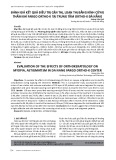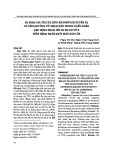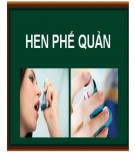
Bài 5: CHỨNG CỨCỦACÁC
Bài
5:
CHỨNG
CỨ
CỦA
CÁC
NGHIÊN CỨU CHẨN ĐOÁN
Matthew J. Thom
p
son
p
GP & Senior Clinical Scientist
Department of Primary Health Care
University of Oxford

N
ộ
i dun
g
bài h
ọ
c
ộgọ
Cơ sở chẩn đoán
Đánh giá các nghiên cứu chẩn
đoán

Chẩnđoán là gì?
Chẩn
đoán
là
gì?
ắ
ắ
Làm tăng độ ch
ắ
cch
ắ
nviệc
mắc hay không mắcbệnh
Tính trầmtrọng củabệnh
Giám sát theo dỏidiểnbiến
lâm sàng
Đ
ánh
g
iá tiên lư
ợ
n
g
-n
g
u
y
cơ
/
g
ợg
gy
các giai đoạncủabệnh
Kếhoạch điềutrị
Kịp
lúc
Kịp
lúc
Knottnerus, BMJ 2002

Sai lầm trong chẩnđoán
Sai
lầm
trong
chẩn
đoán
Hầuhếtcácsailầm trong chẩnđoán là
Hầu
hết
các
sai
lầm
trong
chẩn
đoán
là
cognitive errors:
Conditions of uncertainty
Thinking is pressured
Shortcuts are used
(Ann Croskerry Ann Emerg Med 2003)
(Ann
Croskerry
.
Ann
Emerg
Med
2003)
Những sai lầm trong chẩn đoán (Diagnostic errors -
The next frontier for Patient Safety. Newman-Toker, JAMA 2009)
40 000
80 000 US h it l d th f
40
,
000
-
80
,
000
US
h
osp
it
a
l
d
ea
th
s
f
rom
misdiagnosis per year
Adverse events, negligence cases, serious
Adverse
events,
negligence
cases,
serious
disability more likely to be related to
misdiagnosis than drug errors

Diagnostic reasoning
Diagnostic
reasoning
Diagnostic strategies particularly important
Diagnostic
strategies
particularly
important
where patients present with variety of conditions
and
p
ossible dia
g
noses.
pg












![Bài giảng Vi sinh vật: Đại cương về miễn dịch và ứng dụng [chuẩn nhất]](https://cdn.tailieu.vn/images/document/thumbnail/2025/20251124/royalnguyen223@gmail.com/135x160/49791764038504.jpg)













